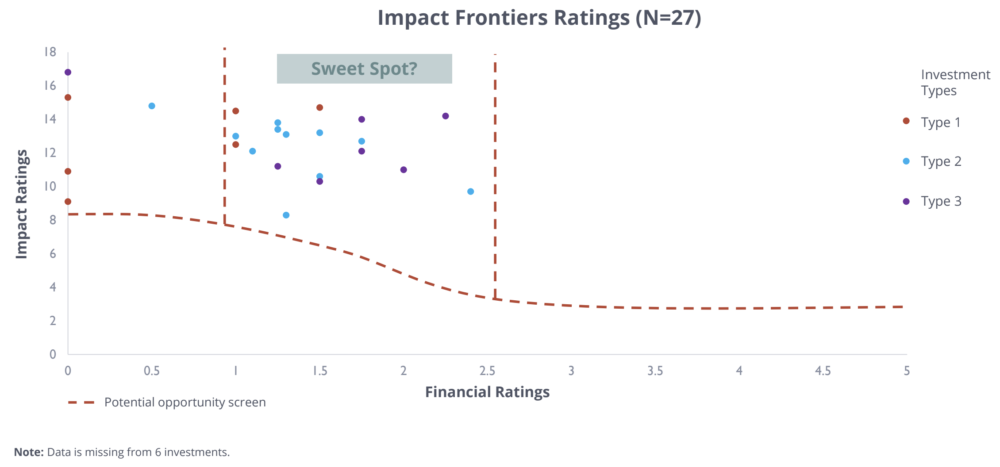As part of a global program, a cohort of asset managers and owners in Canada just spent 18 months grappling with the practical challenges of how to bring impact considerations into the creation and management of their portfolios. While not straightforward, their work was ultimately fruitful. These cohort members are now able to manage their portfolios’ real-world impact alongside financial performance and to see the relationship between the two. Cohort members’ reflections could help others wanting to invest with impact.
Impact investing considerations
The investment sector is used to having standard, widely understood numbers and metrics for financial performance that all investments use. But that’s not the case with impact performance due to the multi-dimensional complexity of impact – as one must consider who is impacted, in what way, and to what degree. For example, the benefits of a company producing renewable energy for Africans and one developing plant-based proteins for North Americans are very different, even though both investments could be within an environmental portfolio. To present a picture of a portfolio’s impact, then, one must use an integrated framework for scoring impact that is relevant to that portfolio.
So that’s what cohort members did.
Overview
Impact Frontiers is an educational initiative to advance the state of impact management practice. Cohort members worked together and studied alone to learn and test new ways to measure and manage impact and integrate impact into their investment practices. Members experimented with new approaches on real portfolios, developed tools to use in their work and gained insights from peers and impact measurement experts.
No Easy Template; Rather, a Replicable Process
Clear about the impact outcomes they were looking for from a portfolio, cohort members then determined which metrics would support attainment of those outcomes. They developed custom frameworks that combined data points, research and analysis to score investments on social and environmental metrics, and then plotted impact metrics against a relevant-to-them financial metric, such as return on equity.
These were custom frameworks that worked for their portfolios – for example, some examined carbon intensity, others the number of new jobs created, and others how well an investment increased the resilience of the local food system.
Cohort members found that a key benefit of this work was its wide applicability and understandability:
- Process was widely applicable. While metrics and resulting graphs were different, cohort members found the process applicable and helpful for everyone. Large asset managers with many varying funds were able to develop a flexible assessment that could be piloted with one fund and then extended across to others. Managers with small staff teams were able to develop a framework that would not be too onerous to maintain.
- Results were widely understood. Cohort members found that the final graphs helped colleagues see and understand impact, and how it could continue to be measured alongside financial performance, supporting company buy-in. Other members found the graphs demonstrated that positive impact contributes to the success of a business – which is valuable when speaking with potential investors.
Portfolio Snapshot

Challenges
Cohort members pointed out several challenges to measuring impact. Many gaps in data, even with more established commonly used metrics like GHG emissions, presented a common challenge, as did inconsistent reporting expectations. But a challenge is sometimes also an opportunity. Several cohort members found the problem of data gaps could be minimized by incorporating a more qualitative approach into scoring and even using storytelling.
Tips for all Investors
- Work with and learn from others. While impact measurement is an emerging field, there is a robust global community of expertise. Working with others within your own team or within wider impact measurement networks is incredibly useful. Different perspectives and experiences will be handy as you experiment, test and roll out a new integrated impact-finance methodology.
- Break away from a siloed perspective. Leading investors examine impact right at the start of their due diligence, and from all angles – company products as well as operations, negative as well as positive impacts, and the interconnection between stakeholders that may affect impact.
- Do. Then Re-do. It’s worth remembering that once an impact scoring framework has been made, it’s not set in stone. New learnings and data will, and indeed should, refine and modify the framework over time.
It is Worth Doing
The hard work to integrate impact is worth it, not least because it meets the growing calls for more transparent, robust and understandable impact measurement, management and reporting in Canada’s investment sector.
The recent 2022 Canadian Responsible Investment Trends Report confirmed there is growing demand for sophistication and more vigilant reporting within responsible investing. The measuring of impact brings that sophistication and vigilance into portfolio creation and reporting, which help managers to ward off concerns around greenwashing, which continue to shape ESG investing.
The approach for integrating impact is adaptable and flexible and works even for those new to impact. And while there are and will continue to be challenges,these are manageable and should not stop you from progressing today on your impact measurement work.
Overall, cohort members learned that relationships between impact and financial risk and return can be analysed empirically and managed proactively. Doing so enables investors to improve their impact performance while meeting their financial goals, set more comprehensive goals for their portfolio and communicate more clearly with colleagues, investors and stakeholders about impact and financial performance.
A Note about the Impact Frontiers Canadian Cohort
The cohort of asset managers and owners were enrolled in the Impact Frontiers program in Canada from spring 2021 to fall 2022. The cohort was made up of participants from large and small asset managers and owners, managing portfolios of varying asset classes, including Anthos Fund & Asset Management, Builders Vision, Cofra Holding, Desjardins Investments, Fair Finance Fund, Foundation of Greater Montreal, Mackenzie Investments, The McConnell Foundation and Raven Indigenous Capital Partners. The Canada cohort was motivated to join and learn from a global network of Impact Frontiers practitioners who are leading impact measurement and management efforts.
Additional Resources:
- https://impactfrontiers.org/ – Resources and further information about Impact Frontiers
- https://www.coursera.org/learn/impact-for-sdgs – A good place to start for those new to impact measurement
- https://impactmanagementplatform.org/ – A collaboration between leading providers of sustainability standards and guidance, this website offers many resources to support the practice of impact management
Contributor’s Note
Rally Assets is an impact investment management and advisory firm. Rally Assets and Impact Frontiers worked with many partners including the RIA to deliver the Impact Frontiers program in Canada. This article brings together ideas from many of the cohort members
RIA Disclaimer
The views and opinions expressed in this article are solely those of the authors and do not necessarily reflect the view or position of the Responsible Investment Association (RIA). The RIA does not endorse, recommend, or guarantee any of the claims made by the authors. This article is intended as general information and not investment advice. We recommend consulting with a qualified advisor or investment professional prior to making any investment or investment-related decision.


